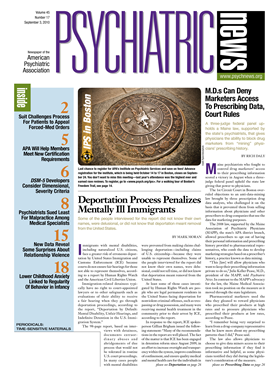Since its introduction in 1996, highly active antiretroviral therapy (HAART) has proven to be a godsend for HIV-infected individuals, reducing HIV viral load in their bodies and leading to long-term disease remission.
Now a new study suggests that HAART might be able to achieve a feat at least as impressive—preventing the spread of HIV. It found that in the Canadian province of British Columbia, newly diagnosed cases of HIV have been more than halved since the introduction of HAART in 1996.
The study was headed by Julio Montaner, M.D., director of the British Columbia Center of Excellence in HIV/AIDS, and colleagues. Results appeared in The Lancet on July 18. Results were also reported at the International AIDS Society Conference in Vienna, Austria, in July.
“This is a very important paper, published in a top journal by one of the leading HIV/AIDS scientists,” Francine Cournos, M.D., a professor of clinical psychiatry at Columbia University and a HIV expert, told Psychiatric News.
“Although this study does not establish a causal relationship between maximizing HAART coverage and decreased HIV infection incidence, it does show a strong link between increasing HAART treatment rates, decreased viral load, and reduced new HIV diagnoses per year,” Antoine Douaihy, M.D., an associate professor of psychiatry at the University of Pittsburgh who has conducted HIV prevention research, added. “This view of HAART has a significant public-health implication in that HAART may serve not only as a treatment for HIV infection, but also as a preventive measure in its transmission.”
Several studies have found that HAART can decrease HIV viral load in semen and in vaginal secretions, and several cohort studies have suggested that HAART treatment can prevent HIV transmission. Montaner and his group decided to undertake a population-based study to explore this possibility.
British Columbia was ideal terrain for such an investigation, they believed, since it has universal health insurance, and thus any resident could have an HIV evaluation or receive treatment for HIV free of charge. The study period they used was 1996 (when HAART became available) to 2009.
They used two separate databases for their study. Data for the number of HIV tests done and new HIV diagnoses in British Columbia from 1996 to 2009 were obtained from the British Columbia Center for Disease Control. That agency centralizes HIV surveillance data for the province. It has access to HIV testing data from the provincial public health reference laboratory, which performs more than 90 percent of HIV testing in British Columbia.
Population Registry Supplied Data
Data for HAART use were extracted from the British Columbia Center of Excellence in HIV/AIDS population-based registries, which included all people on HAART in the province. This center is also the agency that distributes HAART medication in the province, providing it free of charge to all residents infected with HIV.
The researchers then determined how many people in British Columbia had received HAART during the study period and how many had received a new HIV diagnosis during that period, and whether there was any statistically significant difference between the two findings.
During the study period, the number of individuals receiving HAART increased from 837 to 5,413 (a 547 percent increase), and during the same period, the annual number of new HIV diagnoses fell from 702 to 338 (a 52 percent decrease). This difference was highly significant statistically.
Montaner and his colleagues thus believe that their findings constitute powerful evidence that HAART treatment can prevent HIV transmission. Or as Montaner told Psychiatric News: “HAART offers two significant and life-changing benefits—it halts the progression of HIV to AIDS in the individual and dramatically reduces the chances of HIV transmission.”
Another Hypothesis Offered
But there might be another reason than HAART for the decline in HIV cases during the study period, David Scasta, M.D., a Milford, Pa., psychiatrist and former president of the Association of Gay and Lesbian Psychiatrists, suggested during an interview. It may be, he said, that individuals being treated with HAART changed their sexual behavior during the study period. Yet as the researchers pointed out in their paper, “Rates of sexually transmitted infections increased during ... our study, which implies that our findings cannot be accounted for by decreasing sexual HIV risk behavior.”
Thus if HAART treatment is truly able to reduce HIV transmission, as Montaner and his team believe, it could be a powerful weapon for reducing cases of HIV and AIDS around the world. And to this end, he told Psychiatric News, he is urging the G8 nations to “fund universal access to HAART for all eligible people.”
The study was funded by the U.S. National Institute on Drug Abuse's Avant-Garde Award, which is intended to stimulate high-impact research that may lead to groundbreaking opportunities for the prevention and treatment of HIV/AIDS in drug abusers.

